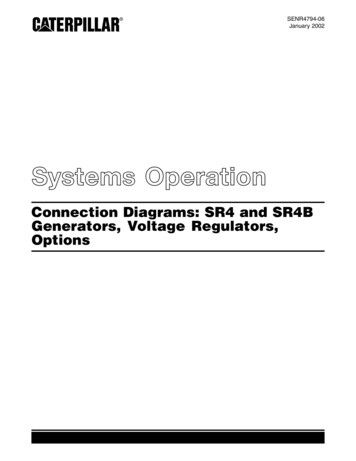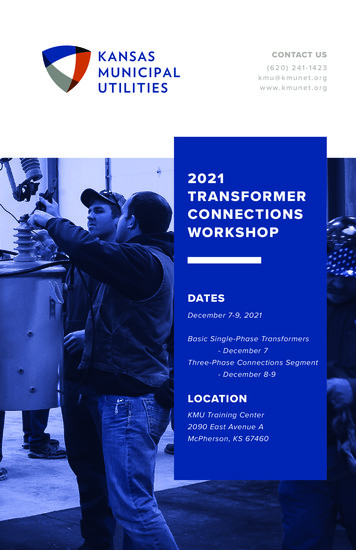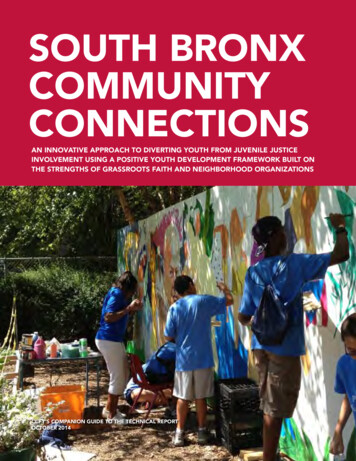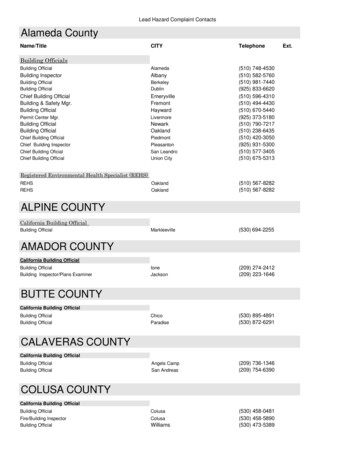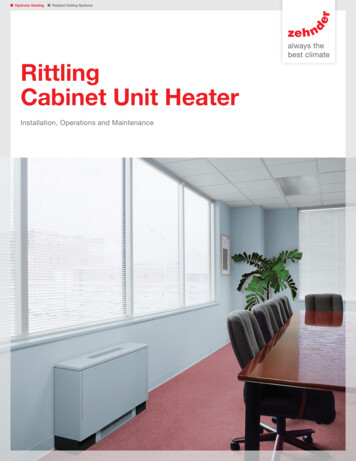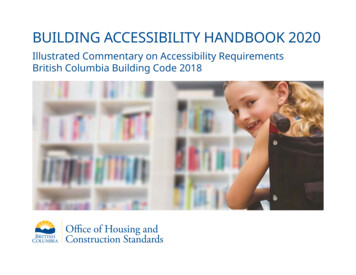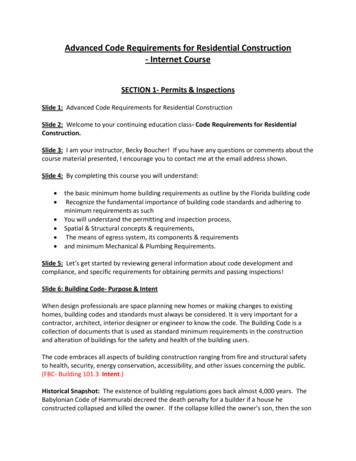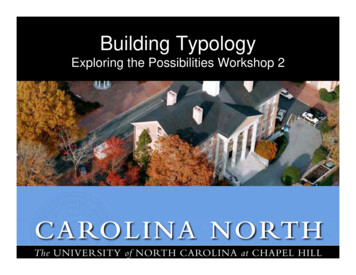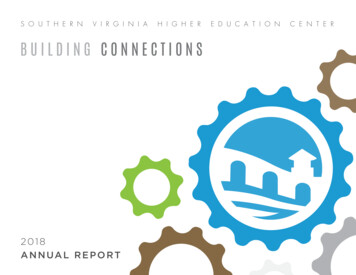
Transcription
S O U T H E R NV I R G I N I AH I G H E RBUILDING CONNECTIONS2018ANNUAL REPORTE D U C A T I O NC E N T E R
CONTENTSPARTNERSK-12Message from the Executive Director . 1The SVHEC’s Impact at a Glance . 3Executive Summary . 5About the SVHEC . 7DEGREESGovernance . 9FUNDINGWORKFORCETECHNICALTRAININGK-12 Connections . 11Literacy Connections . 14Technical Training Connections . 19R&DDegree Connections . 24RESOURCESLITERACYR&D Connections . 26Resource Connections . 29Partner Connections . 37
MESSAGE FROM THE EXECUTIVE DIRECTORNothing captures the SVHEC’s commitment and motivation better than our motto,“OPPORTUNITY LIVES HERE.”For 32 years, the SVHEC has been advancing economic opportunities in Southern Virginia by building essential educationalconnections. The FY2018 Annual Report highlights how the SVHEC and its partners and affiliates are connecting workersand employers with the skills, credentials, degrees, and resources required to succeed in the New Virginia Economy. Theseare the connections that will keep jobs and people in the region we love: connections to literacy, technical training, degrees,research and development technology, and supporting resources. Perhaps most exciting is our growing connection to thenext generation – K-12 students – that promises to build a solid pipeline of skilled and confident adults who can taketransforming Southern Virginia from dream to reality.The SVHEC has grown this year – increasing enrollments in signature programs like the IT Academy and Volunteer LiteracyProgram (VLP), and preparing to launch new ones like its Career Tech Academy. Equally exciting is the economic potentialof ventures on the front burners of the R&D lab this year.In FY2018, the SVHEC also focused on breaking down barriers to education and employment byincreasing connections to fundamental resources like financial assistance, transportation, and housing.These are the connections that enable eager minds to shift their focus from logistics to learning.In closing, and on behalf of the entire SVHEC team, I want to thank our manyextraordinary partners. Our success is your success because collaboration is atthe heart of everything we do. Without your help, the accomplishmentsrevealed in this report would not have been possible.Dr. Betty H. Adams has served as the SVHEC’sexecutive director since 2009.1. —Dr. Betty H. AdamsExecutive Director, the SVHEC2
THE SVHEC’S IMPACT AT A GLANCEENROLLMENTREVENUESFOR CREDIT TOTAL STUDENTS: 1,14593%ASSOCIATESOPPORTUNITYTH E MI SSI O N :LIVES2001Move to BruceStreet Building(former ExportLeaf TobaccoWarehouse)322Partner Fees 4%23%MALE263PELL GRANT RECIPIENTSEducational Victories Economic Strength2008Center ofNursingExcellenceestablishedSoVA Center ofManufacturingExcellence initiated201320122010Innovation Centeropens in formerAmerican TobaccoWarehouseAHEC designation received;SVHEC gets statutoryapproval to deliver non-credittraining SVHEC training;Programs receive NEWCGP& WIOA funding approval;“Experience SVHEC” ative(Presto Project)begins201140%Localities 2%461Donations 1%20152014Work ReadyFoundations introducedSiemens GO-PLM SoftwareTraining Center established377EXPENSES45%55%134Personnel 55%Lease, Utilities, Telecommunication 14.7%Equipment 11.2%Welding@SVHECnamed AWSAccreditedTesting FacilityWORKFORCE TRAINING: 29551%MALENON-WHITE/HISPANIC2018SoVA RegionalTransportationfeasibility studycompleted110ENGLISH AS A SECOND LANGUAGE/ ADULT BASIC EDUCATION20172016IT Academy launchedPearson VUE TestingCenter certified41%LITERACY TOTAL STUDENTS: 244GEDR&D Center forAdvancedManufacturing& Energy EfficiencylaunchedSVHEF 3%AMONG COMMUNITY COLLEGE STUDENTS: 1,067TH E V I SI O N :20051986Grants 15%43NON-WHITE/HISPANICDesignated asa State Agency“to encouragethe expansion ofhigher education”State 64%SVHEC Generated 11%2%GRADUATEAdvancing the economic potential of Southern Virginiathrough education, innovation and collaboration.HERE.Founded in a500-square-footmobile unit onlocal high schoolgrounds4%BACHELORS1,067416INDUSTRY RECOGNIZEDCREDENTIALS EARNEDTHROUGH SVHECTRAINING PROGRAMS43%126Repair/Maintenance,Building & Grounds and Technology 9.3%149Marketing and Educational Support 5.2%Construction - Building Improvements 3.4%Professional Development, Travel, Training 1.2%TOTAL AGENCY EXPENDITURES: 5.98 MSTATE FUNDING: 3.88 M4
EXECUTIVE SUMMARYCONNECTING SOUTHERN VIRGINIANS TO OPPORTUNITYK-12 C O N NE CTIO N SIt’s never too early to begin thinkingabout careers, which is why the SVHECcommits significant resources to K-12outreach. Well-paying STEM-H jobs areavailable in the region, and the SVHECworked hard in FY 2018 to make K-12audiences aware of STEM-H jobs and wheretraining is available to qualify for these jobs.By joining forces with two other VirginiaHigher Education Centers (IALR and NCI)and ramping up the Experience SVHECprogram, the SVHEC touched 6,102 K-12students. We are proud to have attractedthe largest turnout in the Commonwealth forthe Capital One Coders Experience. (p. 10)Through the Capital One One-Day CodersExperience, the SVHEC introduced 107 sixth,seventh, and eighth grade girls from acrossthe Southern Virginia to problem-solving,teamwork, and basic principles of softwaredevelopment.LITERACY C ON N ECTIO N SIncreased literacy levels mean higher levelsof employment, pay, and productivity.Because literacy rates in Southern Virginialag behind other areas, (8 percent of thepopulation has attained an 8th grade orlower education level compared to 4 percent5in Virginia overall), literacy has always beenpart of the SVHEC program mix. Since 1987,the SVHEC has provided literacy-basedprograms under the Volunteer LiteracyProgram (VLP). Financed completely withgrant funding, including substantial supportfrom Dollar General Literacy Foundation,VLP enrollments have grown significantlyin 2018. We served 134 new English as aSecond Language and Adult BasicEducation students in FY 2018—up fromserving 67 students in FY 2017.TECHNICAL CONNECT I ONSThe true ratio of jobs in our economy is1:2:7. 1, 2 Every occupation that requires anadvanced degree (1) is supported bytwo (2) professional jobs requiring auniversity degree, and seven (7) technicaljobs often requiring a short-term credential.These well-paying technical jobs are in greatdemand but are going unfilled in the regionbecause of a lack of skilled workers.The SVHEC has tackled this skills gap bydeveloping a series of short-term, hands-onand stackable credential-based programs inhigh demand areas. In FY 2018, the SVHECpoured energy into launching the CareerTech Academy, a new initiative thatprovides regional high school juniorsand seniors with access to in-demandtechnical training. (p. 19)DEGREE C O N N EC TIO N SR&D C O N N EC TIO N SSince its inception, the SVHEC has beenconnecting citizens to in-demand degreesthrough partnerships with degree-grantinginstitutions. Local community collegepartners, Danville Community College (DCC)and Southside Virginia Community College(SVCC), provide one-year certificates andtwo-year degrees in high demand areasincluding healthcare, business, humanservices, and college parallel. Four-yearpartners Old Dominion University (ODU)and Longwood University provide access toa variety of bachelor’s and master’s degreeprograms. The SVHEC’s Center of NursingExcellence collaborated with SouthsideVirginia Community College to host “ER atSVHEC,” an emergency training simulationfor Southside Virginia Community Collegenursing and EMT students in 2018. (p. 24)The SVHEC strengthens the region’s advancedmanufacturing sector by connectingmanufacturers and entrepreneurs to training,production, proof-of-concept, andcommercialization services through theResearch & Development Center for AdvancedManufacturing & Energy Efficiency (R&D CAMEE).Read on to learn about the Blind Stapler Tool,this year’s proof-of-concept andcommercialization work with potential tobecome a new manufacturing enterprise.R&D CAMEE also works closely with theCommonwealth’s research universities onventures that hold economic potential forSouthern Virginia such as Cross LaminatedTimbers. (p. 26)RESOURCE C O N N EC TIO N SIn 2018, the SVHEC provided connections toimportant resources that increased access toeducation and improved the general quality of life:Financial assistance: Thanks to anumber of scholarship, grant, and tuitionassistance resources, technical trainingparticipants and degree students gainedaccess to a variety of educational opportunitiesin 2018. (p. 29) Gray, K. & Herr, E. (2006). Other Ways to Win: CreatingAlternatives for High School Graduates. Third Edition.Thousand Oaks: Corwin Press.1U.S. Bureau of Labor Statistics. Occupational OutlookHandbook 2012-13. Office of Occupational Statistics andEmployment Projections.2Transportation: By preventingaccess to education and jobs, lackof dependable transportation is akey contributor to poverty. The SoVARegional Transportation Project, a three-yearinitiative led by the SVHEC, is addressingtransportation needs through an effort toestablish two new rural bus routes in hightransportation demand areas. Significantprogress was made this year: a transitprovider was identified and approved,funding to cover locality costs was secured,and grant funding to purchase the newbuses was approved. (p. 31)Housing: It’s a challenge to furtheryour education when you don’thave a stable place to live andstudy. The SVHEC partnered withSouthside Outreach and the Town of SouthBoston to develop The Poplar Creek Homesproject, a low and moderate-income housingdevelopment. The SVHEC will developworkforce training for future Poplar CreekHomes residents and will oversee fundingdevelopment to integrate solar panels andan energy micro-grid to further lower thecost of housing. (p. 35)Healthcare: The CNE and SVHECArea Health Education Center(AHEC) continued focusing the“Nursing is Here” campaign on stemmingthe regional nursing shortage. According toa July 2017 report by the U.S. Departmentof Health and Human Services’ Bureau ofHealth Workforce, Virginia is projected tohave a shortage of 4,400 licensed practicalnurses by 2030. The SVHEC also playeda significant role in securing legislation toestablish the Henrietta Lacks Commission,which will oversee development of theHenrietta Lacks Life Sciences Center inHalifax County.PARTNER C O N N E C T I O N SThe SVHEC would not be where we aretoday without our 94 partners and affiliates.Collaboration is at the heart of everything wedo. Of course, we are also grateful to our 55employees who are the gears that help ouroperations function on a daily basis.Join us on an exploration of the connectionsthat drive the SVHEC. You can set off on alateral course, flipping through the next pagesin order, or you can jump around by flippingto the pages cited above.6
ABOUT THE SVHECThe mission of the Southern Virginia Higher Education Center (SVHEC) is to advanceSouthern Virginia’s economic potential through education, innovation and collaboration.Located in South Boston, more than 75 minutes from the nearest state-supportedfour-year institution and on the fringes of the closest community colleges, the SVHECprovides vital educational access and workforce training to an underserved ruralpopulation. By serving as an incubator, broker and developer of innovative educationaland applied research pathways, the SVHEC is focused on retooling Southern Virginia’srural workforce for jobs in the new economy.Since 1986 the SVHEC has provided access to affordable post-secondary education byforging unique alliances with academic and industry partners. The SVHEC beganoperations in a 500-square-foot mobile unit on the grounds of the local high school.Thanks to a long history of community- and partner-based support, the SVHEC has grownfrom serving a handful of students in its original location to serving more than 1,400 for-credit students and more than 300workforce training participants.Currently located in two repurposed tobacco warehouses donated and renovated with support of local benefactors, taxcredits, and grants, the SVHEC now provides 100,000 square feet of technically sophisticated educational space thatprepares trainees for Science, Technology, Engineering, Math, and Healthcare (STEM-H) careers including nursing, IT,and advanced manufacturing.78
GOVERNANCEK-12 CONNECTIONS2017-2018 BOARD OF TRUSTEESCONNECTING K-12 STUDENTS TO IN-DEMAND, HANDS-ON CAREERSMr. Peter BlakeWe believe the work of preparing Southern Virginia’s future workforce begins today. That’s why we are laser-focusedon introducing K-12 students to exciting, STEM-H careers. We ignite interest and connect students with careerpathways through engaging, hands-on activities.Mr. Gerald “Jay” BurnettMs. Mattie CowanThe Honorable James EdmundsEXP ER IEN C E S V H ECMr. Doug LeeMr. John LeeMr. Paul NicholsDr. Ken Perkins (Designee of President Reveley, Longwood University)Mr. Tom Raab (Designee of Dr. Glenn DuBois, VCCS Chancellor)SOUTHSIDE VIRGINIACOMMUNITY COLLEGELONGWOODUNIVERSITYDr. Al RobertsDr. Bruce ScismThe Honorable Frank M. RuffDANVILLECOMMUNITY COLLEGEThese interactive, 90-minute tours introduce K-12 students to careers ininformation technology, mechatronics, welding, and healthcare.Students tour SVHEC training facilities, meet program leaderswho share information about careers and hands-on training,and participate in hands-on demonstrations. In FY 2018,we connected with 685 K-12 students from 12 differentschools and four counties.The Honorable Dennis WittDr. Charlette WoolridgeThe Honorable Tommy WrightSVHECEXECUTIVE LEADERSHIPDr. Betty H. Adams, Executive DirectorDr. Nettie Simon-Owens, Chief Workforce Development OfficerMrs. Brenda Terry, Chief Finance and Operations Officer9OLD DOMINION UNIVERSITYOur students were able to explore severaldifferent careers and discovered what kindsof job opportunities are available right in our area.The SVHEC field trip inspired our students tothink more about their futures.—Jessica Wright,Clarksville Elementary School guidance counselor2410
K-12 CONNECTIONSK-12 CONNECTIONSS VH E C - A HEC O UTREACH : IN SP IR I NG T HE NEXT GENER AT ION OF H EA LTH CA R E H ER O ESS TEM - H S U M M IT A N D CA R E E R C HO I C E YO U T H E X P O :The SVHEC-Area Health Education Center (SVHEC-AHEC) is federally funded through the Virginia Health WorkforceDevelopment Authority (VHWDA) and was created to facilitate the development of a statewide pipeline of futurehealth professionals. This funding allows us to connect K-12 students and young adults to health professions.Through customized, age appropriate hands-on presentations, career fair exhibits, and health careers explorationthrough individual and small group health careers counseling, we bring the heart-racing excitement of healthcarecareers to life. In FY 2018, we reached 1,051 learners while maintaining regular contact with a database of more than3,800 individuals.Each year, the SVHEC joins with our Southside Higher Education Coalition partners, New College Institute(Martinsville) and the Institute for Advanced Learning & Research (Danville), to co-sponsor the STEM-H Summitand Career ChoICE Youth Expo. The STEM-H Summit is held at the Institute for Advanced Learning & Research inthe spring and brings together more than 250 eleventh and twelfth grade students, teachers, and regional businessand community leaders over two days to advance STEM-H education and workforce developmentin Southern Virginia. SVHEC provides engaging workshops for student attendees andstaffs two information tables to provide resources for hands-on workforce trainingand STEM-H career pathways.The Career ChoICE Youth Expo is held in the fall at the Olde DominionAgricultural Center in Chatham. Over two days, more than 3,800 seventhand ninth grade students from the counties of Halifax, Henry, Patrick,and Pittsylvania and the city of Danville attend the Expo wherethey are introduced to a large number of career clusters inSouthern Virginia. SVHEC staff provides information and hands-ondemonstrations to promote the STEM-H careers of mechatronics,welding, and healthcare.My favorite experience was seeingthe look of awe in the kids’ eyeswhen they made a learning connection.—Career ChoICE Business Participant112412
K-12 CONNECTIONSLITERACY CONNECTIONSCA PI TA L ON E CO DE RS E X PE R IENCEThe SVHEC connected rural middle school girls to computer coding and tech careers when it hosted the Capital OneCoders Experience on October 21, 2017. A one-day event sponsored by the Commonwealth’s Secretary of Technology,Karen Jackson and powered by Capital One, the Coders Experience introduced sixth, seventh and eighth grade girls toproblem-solving, teamwork, and basic principles of software development. Instruction was provided by Capital Oneemployees who donate their time and expertise to serve as instructors and mentors. After instruction, students workedin teams to develop a mobile application.With 107 girls from across Southern Virginia and as far away as Glen Allen, Chesterfield,and Williamsburg in attendance, the SVHEC hosted the largest of the 10 Coders Experiences.Opportunities like this are invaluable becausethey expose students to possibilities that theymay not have known existed. Several parents commentedthat their daughters were so excited they went homeand started designing their next app. Maybe the nextmillion-dollar app will be developed by a youngwoman who got her start at the Coders Experience.—Amy Cole, SVHEC Director of Student & Partner Advancement13CONNECTING FAMILIES TO FOUNDATIONAL LEARNING TO BUILDCONFIDENCE, CAREERS, AND RELATIONSHIPSC H A N GIN G LIV ES O N E AT A T I M ELiteracy is the foundation upon which all other learning occurs. This core tenet hasbeen at the heart of the SVHEC’s commitment to providing free, confidential,one-on-one literacy tutoring for nearly 30 years. With one part-timestaff member and several dedicated volunteers, the SVHEC’s VolunteerLiteracy Program changes lives one by one, week by week.In FY 2018, the SVHEC Volunteer Literacy Program:Served 132 new literacy students.Exceeded program service goals by 88%.Provided more than 700 hours of literacyand English as a Second Language instruction.14
LITERACY CONNECTIONSLITERACY CONNECTIONSLITE R AC Y S UCCE S S S TO RY: SUZA NA J UBELIn June 2017, civil engineer Suzana Jubel left her home country of Braziland the work and home she loved to move to the United States so thather husband Eduardo could pursue his career at ABB in South Boston.Suzana went from a blossoming career to daily struggles because shedidn’t speak English.“I couldn’t even go to the supermarket or pharmacy because I couldn’t speakEnglish, and I didn’t know what to do,” she said. She told Eduardo she neededhelp, and an Internet search led him to the SVHEC’s Volunteer Literacy Englishas a Second Language (ESL) program. Suzana enrolled and began workingone-on-one with Volunteer Literacy/ESL coordinator Judy Ward.Initially, Judy wrote out every word and phrase as she introduced Suzana toEnglish. With each session, Suzana’s vocabulary increased, and in less thana year, she was able to carry on a full verbal conversation. Now, Instead ofavoiding the grocery store, she confidently shops for, and hosts, dinnerparties. Trips to the pharmacy are routine, and she’s now gained theconfidence to re-enter the workforce. She recently completed her firstEnglish-only interview, and she can’t wait to wear her engineer’s hat again.LITER AC Y S U C C ES S S TO R Y : JEREM IA H F O REAfter moving from Fredericksburg, VA, Jeremiah Fore came to the SVHEC topursue training in information technology through Southside Virginia CommunityCollege. As he began the enrollment process, Jeremiah took the college’splacement test and was shocked to learn his results. Though he earned highmarks in math and on the multiple choice English section, he scored a zero—no points—on the writing section.Jeremiah’s college counselor referred him to the Volunteer Literacy Program fortutoring. Literacy Coordinator Judy Ward worked with Jeremiah on sentenceand paragraph structure and provided tips to move him past his writer’s block.Within a few weeks, Jeremiah’s writing improved dramatically, and he was readyto retake the writing section of the placement test.“For my second experience, I didn’t really experience much writer’s block.I was prepared and in the proper mindset. Mrs. Judy really helped me get to thatpoint.” His re-test results were astoundingly better. After working with JudyWard, Jeremiah was placed into English 111 (College Composition), avoiding theseries of developmental English classes prescribed by his first test results.“Judy is amazing. She’s really nice, and she supports me. It’s been a verygood experience,” Suzana said.1516
LITERACY CONNECTIONSLITERACY CONNECTIONSENGLISH AS A SECOND LANGUAGE (ESL) PARTNERSHIP WITH HALIFAX COUNTY PUBLIC SCHOOLSD O IT F O R YO U R C H ILD R E N ( DI FY C )Connecting the non-native English speaking parents of Halifax County Public Schools’ students with the resourcesneeded to enhance their English speaking abilities.Connecting parents with skills to support their child’s academic success.Imagine being a non-native English speaker with a child enrolled in an English-speaking school.How would you help with homework or complete the required forms sent home during the first days of school?Seeing a need to reach non-native speaking parents as well as their children, Halifax County Public Schools (HCPS)partnered with the SVHEC’s Volunteer Literacy Program to establish a language computer lab. HCPS provided thelanguage learning software (Rosetta Stone and Duolingo), and the SVHEC made one of its computer labs availableto HCPS parents.AS A RESULT OF THIS PARTNERSHIP:HCPS parents without computers have been able to access important language learningtools and increase their English speaking abilities.SVHEC’s ESL program has had an increase in students seeking one-on-one tutoring.A group of 10 HCPS students regularly attends SVHEC ESL classes.Ever tried helping your young child with his homework only to find yourself mystified? Thanks to a 10,000 grant fromthe Dollar General Literacy Foundation, the SVHEC Volunteer Literacy Program was able to offer its successful Do ItFor Your Children (DIFYC) outreach program to Sinai Elementary School (Halifax County). Originally pilotedwith two Halifax County elementary schools in 2015, DIFYC brings parents into the classroomto preview lesson plans of the content that will be covered in the upcoming weeks andarm themselves with the knowledge they need to help their children succeed.Teachers and excelling students work with parents to cover the coursematerial, answer questions, and provide tips and strategies for makingliteracy and learning part of everyday life. To make it easy forparents to attend, DIFYC provides meals and childcare.THE RESULT:72 parents servedI liked the hands-onlearning for parents.—DIFYC Parent Participant1718
TECHNICAL TRAINING CONNECTIONSCONNECTING K-12 TO INDUSTRY RECOGNIZED CERTIFICATIONS AND IN-DEMAND SKILLSPublic schools are facing increasing pressure to provide Career & Technical Education (CTE), but CTE programs areexpensive to operate and maintain. Rural public schools in particular have limited resources to fund costly CTE equipment,materials, and teachers. In response to these realities, the SVHEC developed the Career Tech Academy for high schoolstudents from Charlotte, Halifax, and Mecklenburg Counties.The Career Tech Academy (CTA) is a hands-on, regional technical training center located at theSVHEC providing initial career pathways in Information Technology (IT) and Mechatronics.Through the SVHEC’s partnership with Danville Community College and SouthsideVirginia Community College, CTA programs will be offered as dual enrollmentcourses. CTA instructors will teach to the community college’s curriculum, andstudents will receive high school and college credits. In addition, industryrecognized credentials, such as the internationally- recognized SiemensLevel 1 Mechatronics certification, will be embedded into thecoursework. Students who complete all requirements will earn aCareer Studies Certificate, and have the option of using theircredentials to enter the workforce, or to transfer into a communitycollege technical program.CTA’s IT pathway will provide instruction in hardware repair,installing and configuring operating systems, security, andvirtualization and will prepare students to earn the nationallyrecognized CompTIA A and Server certifications. Students in theMechatronics program will receive instruction in electrical circuits andtheory, electrical drawing, residential wiring, programmable logiccontrols (PLCs), hydraulics and pneumatics.TECHNICAL TRAINING CONNECTIONSCTA is offered to high school juniors and seniors, yet SVHEC is mindful that career awareness and explorationbegins much earlier. To impact K-12 students during their formative middle school years, the SVHEC joinedthe GO-TEC (Great Opportunities in Technology and Engineering Careers) regional collaborative.The GO-TEC initiative will provide 6th-8th grade students with hands-on exposure to in-demandcareer pathways. Areas of focus are precision machining; welding, advanced materials,information technology and cybersecurity; robotics, automation, and mechatronics,and advanced materials.The GO-TEC initiative is being funded by a 648,000 competitive grant from theCommonwealth’s GO Virginia (Growth and Opportunity for Virginia) initiative. GO-TEC isa partnership between higher education institutions in Halifax, Pittsylvania, and Henrycounties, and the K-12 school systems in their service areas. Higher education partnersare the Southern Virginia Higher Education Center, Danville Community College,the Institute for Advanced Learning and Research, New College Institute, Patrick HenryCommunity College, and Southside Virginia Community College.GO-TEC sends a strong message to industry that SouthernVirginia is serious about delivering a skilled workforce.—Dr. Betty H. Adams, Executive Director, SVHEC“Without the access provided through the CTA, rural students arelikely to be deprived of access to training that leads to well-paying,in-demand information technology and advanced manufacturing jobs inthe region,” said SVHEC Executive Director Dr. Betty H. Adams.1920
TECHNICAL TRAINING CONNECTIONSTECHNICAL TRAINING CONNECTIONSCUSTOMIZED TRAINING FOR THE RIVERMONT SCHOOLINSTR UC TIONAL DYNAM ICS FO R TE CHN ICAL TR AIN E R SWhen the Rivermont School in Chase City (Mecklenburg County) and Danville (Pittsylvania County) needed a trainingprovider who could offer career pathways exploration and work within a limited timeframe, they reached out to the SVHEC.The SVHEC’s customized training team listened to their needs and worked closely with school administrators to design acustomized curriculum for their high school-aged students.In FY 2018, the SVHEC partnered with Averett University and New College Institute to connect technical trainers to a uniqueprofessional development opportunity. “Instructional Dynamics for Technical Trainers” is a 10-week, non-credit programdesigned to teach subject experts the classroom skills they need to be highly effective trainers and build classroomcompetencies for all levels. This new program was piloted at the SVHEC from April 25 to June 27, 2018. The pilot cohortwas comprised of SVHEC full-time Workforce Development staff, selected part-time trainers, and several small businessowners who will serve as technical training resources for future program initiatives. Three hour class sessions were heldone evening per week for 10 weeks.CONNECTING HIGH SCHOOL STUDENTS TO HANDS-ON CAREER EXPLORATIONTHE RESULT:a 10-week “Work Ready Career Pathways” program that introduced students to careers in welding, woodworking,and mechatronics. The use of Computer Numerical Controls (CNC) was integrated into the curriculum.SVHEC staff delivered 30 training hours of classroom and hands-on lab instruction.Using a series of projects including assembling a wire tree, using the welding simulator,and assembling a solar and electrically powered robot, students were given
of Health and Human Services' Bureau of Health Workforce, Virginia is projected to have a shortage of 4,400 licensed practical nurses by 2030. The SVHEC also played a significant role in securing legislation to establish the Henrietta Lacks Commission, which will oversee development of the Henrietta Lacks Life Sciences Center in Halifax County.
